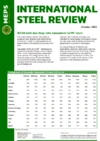MEPS forecast shows short-lived steel price rise in US
Steel mill outages in the United States will provide a temporary lift to steel prices in the final months of 2024, MEPS International’s forecast shows.
Against a backdrop of modest demand, low input costs and US election uncertainty, reduced supply will be the key driver of upward price pressure over the next few months. MEPS forecasts that hot rolled coil and sheet prices will rise modestly through October before moving lower in the final two months of the year.
- Monthly insight on the United States’ carbon steel market is published in MEPS's International Steel Review. This monthly report provides subscribers with steel prices, indices, market commentary and forecasts from key global steel markets. Contact MEPS for details of how to subscribe.
While the US Federal Reserve is widely expected to begin cutting interest rates this month, any resulting uptick in consumer demand is unlikely to be felt in the near term. Furthermore, the purchasing managers’ index for US manufacturing has recently highlighted some concern for the economy. S&P Global’s US Manufacturing PMI remained below 50 for the second consecutive month in August, indicating a sector in contraction. A more discouraging sign was the reference to a “solid reduction in new orders” in S&P's accompanying August PMI report. This will lead to reduced output at manufacturing companies in the coming months.
Steel mills’ production outages
US steel mills have announced maintenance outages in September, October and even into November. Almost one million tonnes of capacity is expected to be taken offline during this period. Nucor, US Steel, Steel Dynamics and Cleveland-Cliffs have all announced outages, primarily affecting flat products.
Ahead of the announced outages, weekly production has been increasing in recent weeks. According to the American Iron and Steel Institute, steel production hit 1.78 million short tons and an 80.2% utilisation in the week ending August 24. This was the strongest result since the summer of 2022. Mills are reportedly stocking up before their planned maintenance, which may reduce some of the consequent influence on prices.
Weaker dollar will limit enthusiasm for imports
Imports are not expected to return to the high levels seen earlier this year, providing some support to steel prices. Given tariff levels, promises of further tariffs and relatively low domestic steel prices, import volumes are unlikely to increase in what remains of 2024.
Imports will also be influenced by the weaker dollar. With the US Federal Reserve expected to begin cutting interest rates this month, the US dollar should weaken against major currencies in the coming months.
The US dollar has enjoyed relative strength against most currencies since the Fed began raising interest rates around two years ago, eventually reaching their highest level for over 20 years in July 2023. A weaker US dollar will lift import prices, making imports less competitive. Of the major currencies, the US dollar may see the most weakness against the Japanese yen due to the Bank of Japan’s recent rates increase – its first since 2007.
Downward pressure on input costs
Downward pressure on steelmakers’ input costs is also expected to undermine any sustained steel price increase. Scrap and iron ore prices are not expected to rise in the coming months.
US scrap prices remain depressed due to weak domestic and export demand. Exports in the six-month period to the end of June 2024 totalled just 14.9 million tonnes – a 15.6% year-on-year decline. With subdued manufacturing growth in Europe and Asia, scrap demand should not improve substantially in 2024. Furthermore, China, the world’s largest iron ore consumer, continues to cut back on steel production due to its continuing construction woes. In July, Chinese steel production data showed a 2.1% decline year-to-date.
Reduced interest rates, US election results and further progress on US government investment programmes will lift steel prices in the early part of 2025. The Fed is expected to cut interest rates at least twice in 2024, setting the stage for stronger investment in 2025.
However, while the CHIPS and IRA spending has been pushed through, the release of funding pledged as part of the US government’s Infrastructure Investment and Jobs Act (IIJA) has, so far, been slow. As the fourth year of the USD1.2 trillion IIJA spending package approaches, the US steel industry should see stronger demand from these projects. MEPS International predicts that US hot rolled coil prices will reach USD900 per short ton in April.
- MEPS International will share its independent insight an exclusive US Steel Market Event at Medinah Country Club, Chicago, Illinois, on October 9. Click here to express an interest in attending MEPS's US Steel Market Event the seminar, which will be hosted by MEPS International and event partners Legacy International Associates.

Source:
International Steel Review
The MEPS International Steel Review is an essential monthly publication, offering professional analysis and insight into carbon steel prices around the world.
Go to productRequest a free publication





